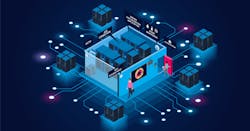Reducing Environmental Impact of Data Centers Starts By Measuring It
The IT sector is under scrutiny as one of the sectors with the highest consumptions of resources these days. Many of us cannot imagine our lives without access to streaming services, banking, mobility, productivity, etc. These cloud-based services are here for good and going backwards to live without them does not seem to be an option. Therefore, we need to analyze the use of resources in the data center to have a starting point for optimization, and that is where comprehensive monitoring come into place.
The usual suspect of the data center carbon footprint is the use of electricity to keep all those boxes running, and maybe also for keeping air conditioning units working. However, it is becoming increasingly important to talk about the use of water for cooling purposes. This is especially true in areas where there are reported draughts, which have raised awareness to the fact that, in general, data centers need big amounts of water to operate.
There are many more efficient cooling services initiatives going to market. Especially interesting are those that are moving away from room cooling to rack cooling, which avoids the mixing of hot air exhaust and cold air output. These solutions are proving the point that power consumption and water consumption can be reduced. The question is to what extent they are being successful.
I like to use a quote often attributed to Peter Drucker, “you cannot improve what you do not measure” when talking to data center professionals. Our business is measuring machine behaviors; we prefer to call it monitoring because of the alerts, data visualization and detection of anomalies that our software platform adds on top of data gathering. But data matters, and in our efficiency projects we rely in sensors and IoT devices to provide us with environmental information. This allows us to keep historical record of energy usage and water usage, broken down to multiple levels of detail, to understand which are the main resource consumers in your day to day.
We call this comprehensive monitoring because you can have a single pane of glass showing information from IT Operations, Facilities, Physical Security, IoT digitalization projects, etc. This allows you to find relationships and behaviors that would not be as evident otherwise; for example, periodical CPU peaks on certain servers caused by faulty database queries that heat up the server room or the rack by x temperature during x amount of time meaning x extra cost for your company. Another example is around open doors in a room or enclosure that’s controlled by the physical security teams. The increase the temperature from the open door requires more power to cool the space down again. If the same tool can detect the open door and the temperature raise you will spend less time investigating what caused the increase in the electricity bill at the end of the month.
Data centers are similar to ecosystems, each actor as little as it might seem, playing a part in the overall result. Comprehensive monitoring allows you to have consistent information, it will alert you when things are not going the expected way, and it will allow you to ultimately make decisions leading to increased efficiency and to lower the environmental impact of your operations.
David Montoya is Global Business Development Manager IoT at Paessler. Paessler offers monitoring solutions for businesses across all industries and all sizes, playing a vital part in reducing humankind's consumption of resources. Whether cloud, hybrid cloud or "on premise”, Paessler ensures the availability and reliability of the infrastructure and building services engineering that are essential for everyday operability.



